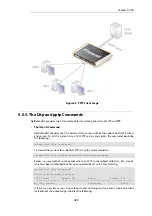
9.5. PPTP/L2TP
The access by a client using a modem link over dial-up public switched networks, possibly with
an unpredictable IP address, to protected networks via a VPN poses particular problems. Both the
PPTP and L2TP protocols provide two different means of achieving VPN access from remote
clients. The most commonly used feature that is relevant in this scenario is the ability of
NetDefendOS to act as either a PPTP or L2TP server and the first two sections below deal with
this. The third section deals with the further ability of NetDefendOS to act as a PPTP or L2TP
client.
PPTP/L2TP Quick Start
This section covers L2TP and PPTP in some detail. A quick start checklist of setup steps for these
protocols in typical scenarios can be found in the following sections:
•
Section 9.2.5, “L2TP/IPsec Roaming Clients with Pre-Shared Keys”
•
Section 9.2.6, “L2TP/IPsec Roaming Clients with Certificates”
.
•
Section 9.2.7, “PPTP Roaming Clients”
9.5.1. PPTP Servers
Overview
Point to Point Tunneling Protocol
(PPTP) is designed by the PPTP Forum, a consortium of
companies that includes Microsoft. It is an OSI layer 2 "data-link" protocol (see
) and is an extension of the older
Point to Point Protocol
(PPP), used for dial-up
Internet access. It was one of the first protocols designed to offer VPN access to remote servers
via dial-up networks and is still widely used.
Implementation
PPTP can be used in the VPN context to tunnel different protocols across the Internet. Tunneling
is achieved by encapsulating PPP packets in IP datagrams using
Generic Routing Encapsulation
(GRE - IP protocol 47). The client first establishes a connection to an ISP in the normal way using
the PPP protocol and then establishes a TCP/IP connection across the Internet to the NetDefend
Firewall, which acts as the PPTP server (TCP port 1723 is used). The ISP is not aware of the VPN
since the tunnel extends from the PPTP server to the client. The PPTP standard does not define
how data is encrypted. Encryption is usually achieved using the
Microsoft Point-to-Point
Encryption
(MPPE) standard.
Deployment
PPTP offers a convenient solution to client access that is simple to deploy. PPTP does not require
the certificate infrastructure found in L2TP but instead relies on a username/password sequence
to establish trust between client and server.
The level of security offered by a non-certificate based solution is arguably one of PPTP's
drawbacks. PPTP also presents some scalability issues with some PPTP servers restricting the
number of simultaneous PPTP clients. Since PPTP does not use IPsec, PPTP connections can be
NATed and NAT traversal is not required. PPTP has been bundled by Microsoft in its operating
systems since Windows95 and therefore has a large number of clients with the software already
installed.
Chapter 9: VPN
729
Summary of Contents for NetDefendOS
Page 30: ...Figure 1 3 Packet Flow Schematic Part III Chapter 1 NetDefendOS Overview 30 ...
Page 32: ...Chapter 1 NetDefendOS Overview 32 ...
Page 144: ...Chapter 2 Management and Maintenance 144 ...
Page 284: ...Chapter 3 Fundamentals 284 ...
Page 392: ...Chapter 4 Routing 392 ...
Page 419: ... Host 2001 DB8 1 MAC 00 90 12 13 14 15 5 Click OK Chapter 5 DHCP Services 419 ...
Page 420: ...Chapter 5 DHCP Services 420 ...
Page 573: ...Chapter 6 Security Mechanisms 573 ...
Page 607: ...Chapter 7 Address Translation 607 ...
Page 666: ...Chapter 8 User Authentication 666 ...
Page 775: ...Chapter 9 VPN 775 ...
Page 819: ...Chapter 10 Traffic Management 819 ...
Page 842: ...Chapter 11 High Availability 842 ...
Page 866: ...Default Enabled Chapter 13 Advanced Settings 866 ...
Page 879: ...Chapter 13 Advanced Settings 879 ...






























